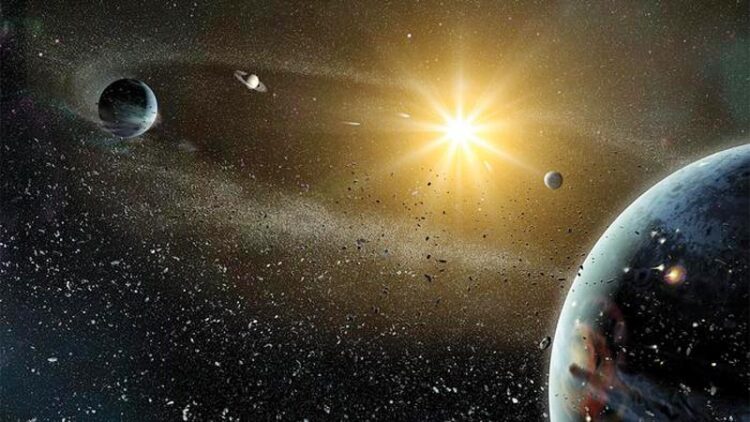Giant planets cast a deadly pall

Artist's depiction of an extra-solar system that is crowded with giant planets.
Credit: NASA/Dana Berry
How they can prevent life in other solar systems.
Giant gas planets can be agents of chaos, ensuring nothing lives on their Earth-like neighbors around other stars. New studies show, in some planetary systems, the giants tend to kick smaller planets out of orbit and wreak havoc on their climates.
Jupiter, by far the biggest planet in our solar system, plays an important protective role. Its enormous gravitational field deflects comets and asteroids that might otherwise hit Earth, helping create a stable environment for life. However, giant planets elsewhere in the universe do not necessarily protect life on their smaller, rocky planet neighbors.
A new Astronomical Journal paper details how the pull of massive planets in a nearby star system are likely to toss their Earth-like neighbors out of the “habitable zone.” This zone is defined as the range of distances from a star that are warm enough for liquid water to exist on a planet’s surface, making life possible.
Unlike most other known solar systems, the four giant planets in HD 141399 are farther from their star. This makes it a good model for comparison with our solar system where Jupiter and Saturn are also relatively far from the sun.
“It’s as if they have four Jupiters acting like wrecking balls, throwing everything out of whack,” said Stephen Kane, UC Riverside astrophysicist and author of the journal paper.
Taking data about the system’s planets into account, Kane ran multiple computer simulations to understand the effect of these four giants. He wanted specifically to look at the habitable zone in this star system and see if an Earth could remain in a stable orbit there.
“The answer is yes, but it’s very unlikely. There are only a select few areas where the giants’ gravitational pull would not knock a rocky planet out of its orbit and send it flying right out of the zone,” Kane said.
While this paper shows giant planets outside the habitable zone destroying the chances for life, a second, related paper shows how one big planet in the middle of the zone would have a similar effect.
Also published in the Astronomical Journal, this second paper examines a star system only 30 light years away from Earth called GJ 357. For reference, the galaxy is estimated to be 100,000 light years in diameter, so this system is “definitely in our neighborhood,” Kane said.
Earlier studies found that a planet in this system, named GJ 357 d, resides in the system’s habitable zone and has been measured at about six times the mass of the Earth. However, in this paper titled “Agent of Chaos,” Kane shows the mass is likely much bigger.
“It’s possible GJ 357 d is as much as 10 Earth masses, which means it’s probably not terrestrial, so you couldn’t have life on it,” Kane said. “Or at least, it would not be able to host life as we know it.”
In the second part of the paper, Kane and his collaborator, UCR planetary science postdoctoral scholar Tara Fetherolf, demonstrate that if the planet is much larger than previously believed, it is certain to prevent more Earth-like planets from residing in the habitable zone alongside it.
Though there are also a select few locations in the habitable zone of this system where an Earth could potentially reside, their orbits would be highly elliptical around the star. “In other words, the orbits would produce crazy climates on those planets,” Kane said. “This paper is really a warning, when we find planets in the habitable zone, not to assume they are automatically capable of hosting life.”
Ultimately, the pair of papers shows how uncommon it is to find the right set of circumstances to host life elsewhere in the universe. “Our work gives us more reasons to be very grateful for the particular planetary configuration we have in our solar system,” Kane said.
Journal: The Astronomical Journal
DOI: 10.3847/1538-3881/acfb01
Article Title: Surrounded by Giants: Habitable Zone Stability Within the HD 141399 System
Article Publication Date: 10-Oct-2023
Media Contact
Jules Bernstein
University of California – Riverside
Jules.Bernstein@ucr.edu
Office: United States
All latest news from the category: Physics and Astronomy
This area deals with the fundamental laws and building blocks of nature and how they interact, the properties and the behavior of matter, and research into space and time and their structures.
innovations-report provides in-depth reports and articles on subjects such as astrophysics, laser technologies, nuclear, quantum, particle and solid-state physics, nanotechnologies, planetary research and findings (Mars, Venus) and developments related to the Hubble Telescope.
Newest articles

Innovative 3D printed scaffolds offer new hope for bone healing
Researchers at the Institute for Bioengineering of Catalonia have developed novel 3D printed PLA-CaP scaffolds that promote blood vessel formation, ensuring better healing and regeneration of bone tissue. Bone is…

The surprising role of gut infection in Alzheimer’s disease
ASU- and Banner Alzheimer’s Institute-led study implicates link between a common virus and the disease, which travels from the gut to the brain and may be a target for antiviral…

Molecular gardening: New enzymes discovered for protein modification pruning
How deubiquitinases USP53 and USP54 cleave long polyubiquitin chains and how the former is linked to liver disease in children. Deubiquitinases (DUBs) are enzymes used by cells to trim protein…


